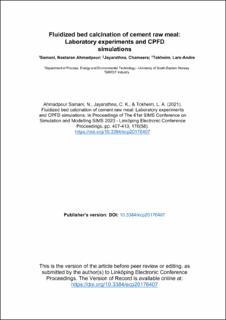| dc.contributor.author | Samani, Nastaran Ahmadpour | |
| dc.contributor.author | Jayarathna, Chameera | |
| dc.contributor.author | Tokheim, Lars-Andre | |
| dc.date.accessioned | 2021-07-01T10:56:27Z | |
| dc.date.available | 2021-07-01T10:56:27Z | |
| dc.date.created | 2021-01-18T09:15:36Z | |
| dc.date.issued | 2020 | |
| dc.identifier.citation | Ahmadpour Samani, N., Jayarathna, C. K., & Tokheim, L. A. (2021). Fluidized bed calcination of cement raw meal: Laboratory experiments and CPFD simulations. In Proceedings of The 61st SIMS Conference on Simulation and Modelling SIMS 2020 - Linköping Electronic Conference Proceedings, 176(58). | en_US |
| dc.identifier.issn | 1650-3686 | |
| dc.identifier.uri | https://hdl.handle.net/11250/2762771 | |
| dc.description.abstract | The chemical and thermal processes associated with the decarbonation and fuel combustion in the cement kiln process produce a large amount of carbon dioxide (CO2) contributing with around 8 % of the global CO2 emissions. Utilizing green electricity instead of fossil fuels to decarbonate the raw meal in the calciner can eliminate the CO2 emissions produced through fuel combustion and also provide a basis for simple capture of the CO2 generated through calcination because CO2 is the only gaseous product exiting from the electrified calciner. In the current work, an electrically heated fluidized bed (FB) reactor is being developed to calcine the raw meal. The FB may replace the traditional entrainment calciner used in many plants. The purpose is to enable efficient indirect heat transfer in the bubbling bed and hence obtain pure CO2 as the gaseous product from the calciner. The minimum fluidization velocity and pressure drop of the particle bed are important characteristics in the design of a bubbling fluidized bed, and these have been measured in a cold-flow lab-scale fluidized bed unit. The particle size distribution of the meal ranged from 0.2 – 180 µm, with a median particle size of 21 µm. The experimental results revealed that the regular cement raw meal is difficult to fluidize due to the large fraction of Geldart C particles in the meal. Based on experimental observation, this may be explained by inter-particular electrostatic forces forming particle clusters. The fluidization process has also been simulated with the commercial computational particle and fluid dynamics (CPFD) software Barracuda® (version 17.4.1). The purpose of using CPFD was to be able to simulate the process at cold-flow conditions and then, based on this, simulate the process at large-scale hot-flow conditions. The simulation results complied quite well with the lab-scale experiments and confirmed the difficult fluidization of the meal. | en_US |
| dc.language.iso | eng | en_US |
| dc.rights | Navngivelse-Ikkekommersiell 4.0 Internasjonal | * |
| dc.rights.uri | http://creativecommons.org/licenses/by-nc/4.0/deed.no | * |
| dc.title | Fluidized bed calcination of cement raw meal: Laboratory experiments and CPFD simulations | en_US |
| dc.type | Journal article | |
| dc.description.version | submittedVersion | en_US |
| dc.rights.holder | © The Author(s) 2020. | en_US |
| dc.source.volume | 176 | en_US |
| dc.source.journal | Linköping Electronic Conference Proceedings | en_US |
| dc.source.issue | 58 | en_US |
| dc.identifier.doi | https://doi.org/10.3384/ecp20176407 | |
| dc.identifier.cristin | 1872825 | |
| cristin.ispublished | true | |
| cristin.fulltext | preprint | |
| cristin.qualitycode | 1 | |

